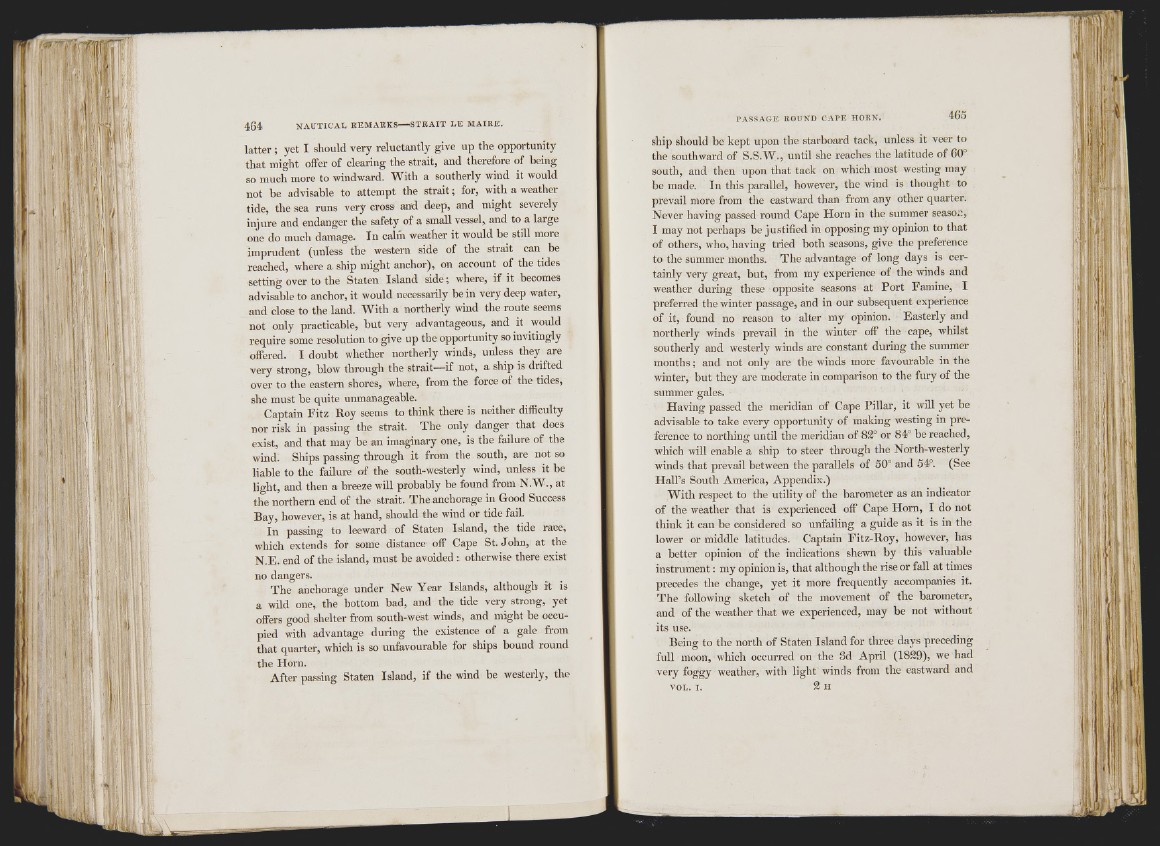
Ü
I t
i' I
latter ; yet I should very reluctantly give up the opportunity
that might offer of clearing the strait, and therefore of being
so much more to windward. With a southerly wind it would
not be advisable to attempt the strait; for, with a weather
tide, the sea runs very cross and deep, and might severely
injure and endanger the safety of a small vessel, and to a large
one do much damage. In calm weather it would be still more
imprudent (unless the western side of the strait can be
reached, where a ship might anchor), on account of the tides
setting over to the Staten Island side ; where, if it becomes
advisable to anchor, it would necessarily he in very deep water,
and close to the land. With a northerly wind the route seems
not only practicable, but very advantageous, and it would
require some resolution to give up the opportunity so invitingly
offered. I doubt whether northerly winds, unless they are
very strong, blow through the strait—if not, a ship is drifted
over to the eastern shores, where, from the force of the tides,
she must be quite unmanageable.
Captain Fitz Roy seems to think there is neither difficulty
nor risk in passing the strait. The only danger that does
exist, and that may be an imaginary one, is the failure of the
wind. Ships passing through it from the south, are not so
liable to the faüure of the south-westerly wind, unless it be
light, and then a breeze will probably be found from N.W., at
the northern end of the strait. The anchorage in Good Success
Bay, however, is at hand, should the wind or tide fail.
In passing to leeward of Staten Island, the tide race,
which extends for some distance off Cape St. John, at the
N.E. end of the island, must be avoided : otherwise there exist
no dangers.
The anchorage under New Year Islands, although it is
a wild one, the bottom bad, and the tide very strong, yet
offers good shelter from south-west winds, and might be occupied
with advantage during the existence of a gale from
that quarter, which is so unfavourable for ships bound round
the Horn.
After passing Staten Island, if the wind be westerly, the
ship should be kept upon the starboard tack, unless it veer to
the southward of S.S.W-, until she reaches the latitude of 60°
south, aud then upon that tack on which most westing may
be made. In this parallel, however, the wind is thought to
prevail more from the eastward than from any other quarter.
Never having passed round Cape Horn in the summer season,
I may not perhaps be justified in opposing my opimon to that
of others, who, having tried both seasons, give the preference
to the summer months. The advantage of long days is certainly
very great, but, from my experience of the winds and
weather during these opposite seasons at Port Famine, I
preferred the winter passage, and in our subsequent experience
of it, found no reason to alter my opinion. - Easterly and
northerly winds prevail in the winter off the cape, whilst
southerly and westerly winds are constant during the summer
months; and not only are the winds more favourable in the
winter, but they are moderate in comparison to the fury of the
summer gales.
Having passed the meridian of Cape Pillar, it will yet be
advisable to take every opportunity of making westing in preference
to northing until the meridian of 82° or 84° be reached,
which will enable a ship to steer through the North-westerly
winds that prevail between the parallels of 50° and 54°. (See
Hall’s South America, Appendix.)
With respect to the utility of the barometer as an indicator
of the weather that is experienced off Cape Horn, I do not
think it can be considered so unfailing a guide as it is in the
lower or middle latitudes. Captain Fitz-Roy, however, has
a better opinion of the indications shewn by this valuable
instrument; my opinion is, that although the rise or fall at times
precedes the change, yet it more frequently accompanies it.
The following sketch of the movement of the barometer,
and of the weather that we experienced, may be not without
its use.
Being to the north of Staten Island for three days preceding
full moon, which occurred on the 3d April (1829), we had
very foggy weather, with light winds from the eastward and
VOL, I. 2 H
i i
II